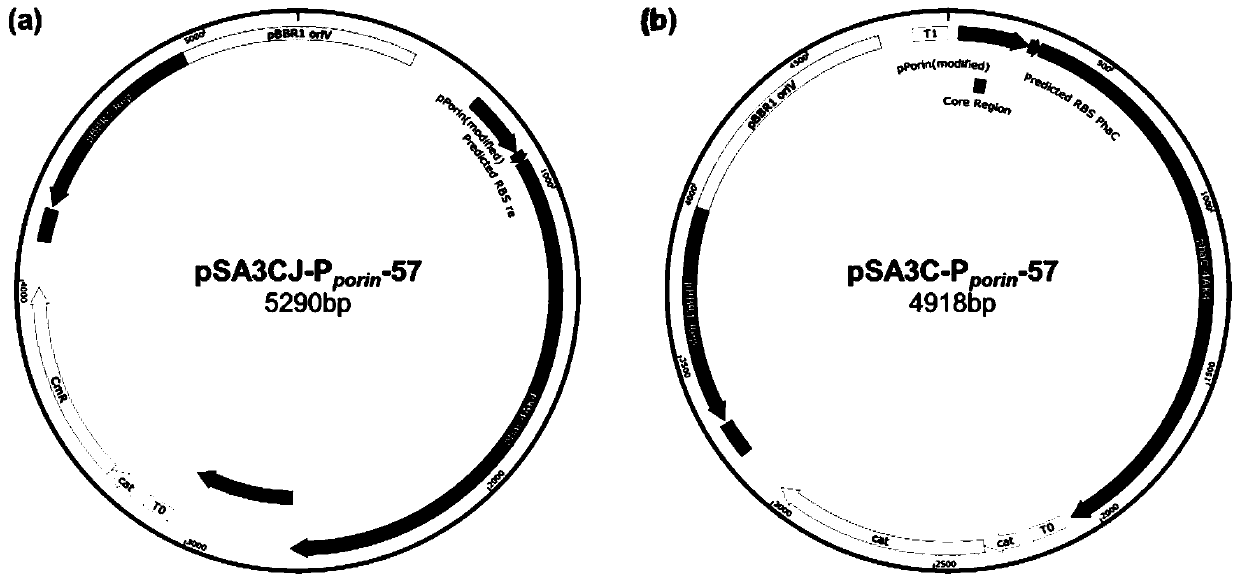Method for producing short-and-medium-chain-length polyhydroxyalkanoate (PHA) and functional derivatives thereof
A technology of chain polyhydroxyalkanoates and derivatives, applied in the fields of biotechnology and materials, can solve the problems of easy contamination, consumption of a large amount, and difficulty in controlling the ratio of short and medium-chain PHA monomers.
- Summary
- Abstract
- Description
- Claims
- Application Information
AI Technical Summary
Problems solved by technology
Method used
Image
Examples
preparation example Construction
[0092] The preparation method of the seed liquid in the following examples is as follows: 1) strain activation: get the strain glycerol tube stored in the -80°C refrigerator, and inoculate it into the 60-LB medium containing 25mg / L chloramphenicol plate, cultured at 37°C for 24-36h. 2) First-class seeds: Pick a single colony from the plate that completed step 1, inoculate it in 20 mL of liquid 60-LB medium containing 25 mg / L chloramphenicol, and culture it with shaking at 37°C and 200 rpm for 24 hours. 3) Secondary seed: Take the primary seed liquid obtained in step 2, inoculate it into 20 mL liquid 60-LB medium containing 25 mg / L chloramphenicol according to the inoculum size of 1%, and culture it with shaking at 37° C. and 200 rpm for 8-10 hours.
[0093] The fermentation culture method in the following examples is specifically as follows: 1) Preparation of seed liquid: refer to the preparation method of the above-mentioned seed liquid. 2) Preparation of fermentation medium...
Embodiment 1
[0105] Example 1. Controllable production of short and medium chain PHA [P(3HB-co-3HHx)] using recombinant Halomonas
[0106] 1. Construction of Recombinant Halomonas
[0107] 1. Construction of endogenous phaC gene-deficient strain H. bluephagenesis TDCKO3
[0108] 1) Extract the genomic DNA of Halomonas H. bluephagenesis TD01, and use it as a template to clone homologous fragments phaC-HR-L-3 and phaC-HR-R-3 with a length of 500 bp, respectively. It is located upstream and downstream of the phaC gene of H. bluephagenesis TD01.
[0109] 2) Using pQ31 (construct the backbone plasmid for CRISPR / Cas9 knockout gRNA [Qin, Q., Ling, C., Zhao, Y.Q., Yang, T., Yin, J., Guo, Y.Y., and Chen, G.Q. (2018) CRISPR / Cas9 editing genome of extremophile Halomonas spp., Metab.Eng.47, 219-229.]) as a template, the two homologous fragments and the backbone fragment of pQ31 were amplified by PCR, and constructed by One-spot method pTDCKO3-donor plasmid, based on the correct pTDCKO3-donor plasmi...
Embodiment 2
[0162] Example 2. Controllable production of short and medium chain functional PHA [P(3HB-co-3HHxE)] using recombinant Halomonas
[0163] 1. Preparation of recombinant Halomonas H. bluephagenesis TDCKO3 (pSA3CJ-P porin -57) seed solution.
[0164] 2. Fermentation with glucose and different concentrations of hexenoic acid as dual carbon sources
[0165] Get 2.5mL of the recombinant Halomonas H.bluephagenesis TDCKO3 (pSA3CJ-P porin -57) Seed solution, inoculated in a 500 mL shake flask containing 47.5 mL of shake flask culture medium, cultured with shaking at 37° C. and 200 rpm for 48 hours.
[0166] Shake flask medium is any of the following:
[0167] Shake flask medium 10G+0.25HEA: 60-MM medium containing 25mg / L chloramphenicol, 10g / L glucose and 0.25g / L 5-hexenoic acid;
[0168] Shake flask medium 10G+0.5HEA: 60-MM medium containing 25mg / L chloramphenicol, 10g / L glucose and 0.5g / L 5-hexenoic acid;
[0169] Shake flask medium 10G+1HEA: 60-MM medium containing 25mg / L chlor...
PUM
| Property | Measurement | Unit |
|---|---|---|
| concentration | aaaaa | aaaaa |
Abstract
Description
Claims
Application Information
 Login to View More
Login to View More - R&D
- Intellectual Property
- Life Sciences
- Materials
- Tech Scout
- Unparalleled Data Quality
- Higher Quality Content
- 60% Fewer Hallucinations
Browse by: Latest US Patents, China's latest patents, Technical Efficacy Thesaurus, Application Domain, Technology Topic, Popular Technical Reports.
© 2025 PatSnap. All rights reserved.Legal|Privacy policy|Modern Slavery Act Transparency Statement|Sitemap|About US| Contact US: help@patsnap.com



